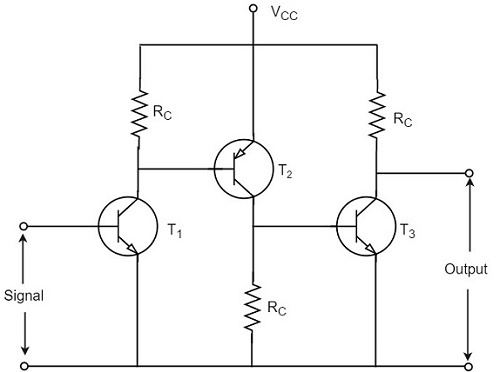
- Amplifiers Tutorial
- Amplifiers - Home
- Materials - Introduction
- Transistors
- Transistors - Overview
- Transistor Configurations
- Transistor Regions of Operation
- Transistor Load Line Analysis
- Operating Point
- Transistor as an Amplifier
- Transistor Biasing
- Methods of Transistor Biasing
- Bias Compensation
- Amplifiers
- Basic Amplifier
- Classification of Amplifiers
- Based on Configurations
- Multi-Stage Transistor Amplifier
- RC Coupling Amplifier
- Transformer Coupled Amplifier
- Direct Coupled Amplifier
- Power Amplifiers
- Classification of Power Amplifiers
- Class A Power Amplifiers
- Transformer Coupled Class A Power Amplifier
- Push-Pull Class A Power Amplifier
- Class B Power Amplifier
- Class AB and C Power Amplifiers
- Tuned Amplifiers
- Types of Tuned Amplifiers
- Feedback Amplifiers
- Negative Feedback Amplifiers
- Emitter Follower & Darlington Amplifier
- Noise in Amplifiers
- Amplifiers Useful Resources
- Amplifiers - Quick Guide
- Amplifiers - Useful Resources
- Amplifiers - Discussion
Direct Coupled Amplifier
The other type of coupling amplifier is the direct coupled amplifier, which is especially used to amplify lower frequencies, such as amplifying photo-electric current or thermo-couple current or so.
Direct Coupled Amplifier
As no coupling devices are used, the coupling of the amplifier stages is done directly and hence called as Direct coupled amplifier.
Construction
The figure below indicates the three stage direct coupled transistor amplifier. The output of first stage transistor T1 is connected to the input of second stage transistor T2.

The transistor in the first stage will be an NPN transistor, while the transistor in the next stage will be a PNP transistor and so on. This is because, the variations in one transistor tend to cancel the variations in the other. The rise in the collector current and the variation in β of one transistor gets cancelled by the decrease in the other.
Operation
The input signal when applied at the base of transistor T1, it gets amplified due to the transistor action and the amplified output appears at the collector resistor Rc of transistor T1. This output is applied to the base of transistor T2 which further amplifies the signal. In this way, a signal is amplified in a direct coupled amplifier circuit.
Advantages
The advantages of direct coupled amplifier are as follows.
The circuit arrangement is simple because of minimum use of resistors.
The circuit is of low cost because of the absence of expensive coupling devices.
Disadvantages
The disadvantages of direct coupled amplifier are as follows.
- It cannot be used for amplifying high frequencies.
- The operating point is shifted due to temperature variations.
Applications
The applications of direct coupled amplifier are as follows.
- Low frequency amplifications.
- Low current amplifications.
Comparisions
Let us try to compare the characteristics of different types of coupling methods discussed till now.
| S.No | Particular | RC Coupling | Transformer Coupling | Direct Coupling |
|---|---|---|---|---|
| 1 | Frequency response | Excellent in audio frequency range | Poor | Best |
| 2 | Cost | Less | More | Least |
| 3 | Space and Weight | Less | More | Least |
| 4 | Impedance matching | Not good | Excellent | Good |
| 5 | Use | For voltage amplification | For Power amplification | For amplifying extremely low frequencies |